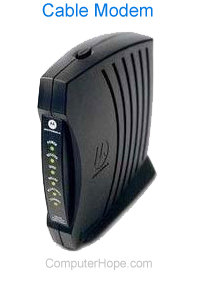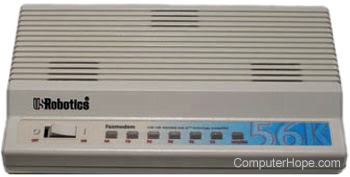Modem
A modem may refer to any of the following:

1. A modem or broadband modem is a hardware device that connects a computer or router to a broadband network. For example, a cable modem and a DSL modem are two examples of these modems.
Today, a "modem" often describes a broadband modem. However, it also describes what was initially considered a modem (described below) to connect to the Internet. To help prevent confusion, use the terms "broadband modem" and "dial-up modem."
A broadband modem is an external device that connects to your computers and other network devices using a network cable or over a wireless connection.
2. Short for modulator/demodulator, a modem is a hardware device that allows a computer to send and receive information over telephone lines. When sending a signal, the device converts ("modulates") digital data to an analog audio signal and transmits it over a telephone line. Similarly, when an analog signal is received, the modem converts it back ("demodulates" it) to a digital signal.
To help prevent confusion with a broadband modem, refer to this modem as a "dial-up modem."
The picture below is an example of an internal expansion card dial-up modem. Click the image to get a description of each component on the card.
Modems are called an asynchronous device, meaning that the device transmits data in an intermittent stream of small packets. Once received, the receiving system takes the data in the packets and reassembles it into a form the computer can use.
| Stop 1 bit |
Data 8 bits |
Start 1 bit |
Stop 1 bit |
Data 8 bits |
Start 1 bit |
| Packet 10 bits |
Packet 10 bits |
||||
The above chart represents how an asynchronous transmission transmits over a phone line. In asynchronous communication, one byte (eight bits) is transferred within one packet, equivalent to one character. However, for the computer to receive this information, each packet must contain a Start and a Stop bit; therefore, the complete packet would be ten bits. The above chart is a transmission of the word "HI," equivalent to two bytes (16-bits).
History of the modem
The first modem, known as the Dataphone, was released by AT&T in 1960. It became more common for home users when Dennis Hayes and Dale Heatherington released the 80-103A modem in 1977.
Most computers used dial-up modems until the early 2000s when broadband Internet became more widely available. As broadband Internet became available and popular, dial-up modems were used by fewer computer users. Today, computers no longer come with a dial-up modem, requiring users who need one to purchase and install it.
Modem was featured as a top term of 1995.
What does a modem sound like?
If you didn't grow up on a dial-up modem or are nostalgic, you can listen to a modem connecting to the Internet in the sound file below. Whenever someone connected to the Internet, they heard these noises over the modem speaker.
In this audio file, you hear the modem dialing a phone number and then communicating with the other modem over the phone. The squealing noise heard after the phone number is the modem establishing a connection (handshaking). When the connection is established, the modem goes silent.
If someone picked up another phone sharing the same line they would hear the modem squealing and may interrupt the connection.
Why does a modem need to make this noise?
The computer uses a digital signal. However, a phone line was designed for voices and uses an analog signal. The modem makes these noises and tones to transmit digital information over an analog line.
Types of computer modems
Below are the four versions of a computer modem found in computers.
Onboard modem - Modem built onto the computer motherboard. These modems cannot be removed but can be disabled through a jumper or BIOS setup.
Internal modem - Modem that connects to a PCI (peripheral component interconnect) slot inside a newer desktop computer or ISA (Industry Standard Architecture) slot on older computer. The internal modem shown above is an example of a PCI modem.

External modem - Modem in a box that connects to the computer externally, using a serial port or USB (universal serial bus) port. The picture shows an external USRobotics modem.
Removable modem - Modem used with older laptops PCMCIA slot that could be added or removed as needed.
What are the speeds of modems?
Modem speed is measured in bps and Kbps, the speed the modem can send and receive data. Today, a 56 K (56,000 bps) modem is the fastest solution and speed used with today's dial-up modem.
The line quality of the phone line and how many collocations it must use also affects the modem's speed. Although a modem may be rated as 56 K, if the line quality and collocations are not optimal, you cannot achieve the maximum speed. Also, the lowest speed of the two modems is used when establishing a connection.
Earlier speeds of modems included 110 baud, 300 baud, 1200 baud, 2400 baud, 4800 baud, 9600 baud, 14.4k, 28.8k, and 33.6k.
Modem features and standards
A modem may include some or all of the features and specifications listed below.
- Auto-answer - A modem's ability to automatically answer the phone after the phone rings at a set time.
- Data/Voice - Modems with voice capability that switch between voice and data communication.
- Fax - Fax modems can send and receive a fax with the proper software.
- V.90 - The modem's standard uses also allows it to communicate at an optimal speed. When introduced, there were multiple standards, but nearly all 56 K modems use the V.90 standard today.
Why is a modem an input and output device?
A Modem is considered an input and output device because it sends data (upload/output) and receives data (download/input).
Should I write "MODEM" or "modem" in my writing?
Although "modem" is short for "modulator/demodulator," it is no longer written in all uppercase and should follow sentence case (lowercase, unless the first word of the sentence).
Acoustic coupler, Cable modem, Computer abbreviations, Computer portmanteaus, Connection, Dataphone, Dial-up, External modem, Hardware terms, Internet terms, Modem terms, Modulate, RJ-11, RS-232, RTS, RXD

